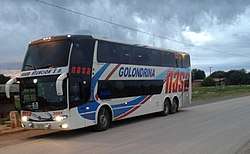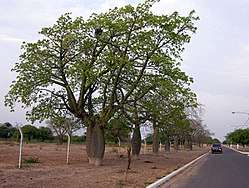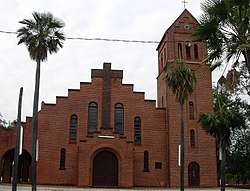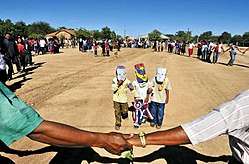Mariscal Estigarribia
Mariscal Estigarribia is a town in Boquerón department in western Paraguay that due to its remote location in the middle of the desert-like Chaco region has a kind of faraway atmosphere.
At 520 km (323 mi) northwest from Asunción on the Transchaco Highway this is the farthest place from the capital with tourist services for those travelling on the Transchaco, so you must stop here to stock up of suplies before going any further into the wilderness of the Chaco. It is also a mandatory stop if you plan to continue to Bolivia, 231 km (144 mi) following the Transchaco to the west, or Salta Province in northern Argentina, taking the Picada 500 route 223 km (139 mi) to the southwest, because the Paraguayan customs and immigration office is here, so you will have to go through them and get your passport stamped in order to leave the country.
Understand

Mariscal Estigarribia (or simply Mariscal) is mostly used by travellers as the starting point for touring the attractions of the central and northern Chaco. There are at least three national parks in the region, as well as a number of private nature reserves, some welcoming indigenous communities, and several historical sites from the Chaco War. All are accessible from Mariscal, however it is recommended to venture into the Chaco only with a guided tour which can last from one to two/three days.
History
Founded as Fortín Camacho, it was founded in the 1920s as a military outpost of Bolivia. It was then taken by the Paraguayans during the bloody Paraguay-Bolivia Chaco War of 1932-35 and renamed in 1933 as Fortín López de Filipis.
When the war ended and a peace agreement was signed in 1938, it was converted into a permanent military detachment and was renamed again in 1944 to Mariscal Estigarribia after José Félix Estigarribia who was the general that successfully commanded the Paraguayan army during the conflict. General Estigarribia had been declared a national hero of Paraguay and promoted to the rank of marshal after his tragic death in a plane crash in 1941.
In the following years a large military base was established by the Paraguayan government to prevent another conflict from erupting with Bolivia. The arrival of the soldiers with their families laid out the groundwork for the birth of Mariscal as a town.
In the 1980s, during the Cold War, a giant military airport, one of the largest in South America, was built presumably with support of the United States to use it as an airbase that would allow a quick deployment of troops, just in case the need arose, in an unpopulated spot in the center of the South American continent, but it has never been used.
Economy

Mariscal is, unlike the other towns of the central Chaco, not a Mennonite colony where industries prevail over small businesses, so the local economy is more of the kind of a frontier town with services that cater mostly to military personnel who live in the base, truck drivers of the Transchaco transporting goods to/from Bolivia, farmers and ranchers coming to town to stock up of suplies, and travellers on the go that use Mariscal as a base to explore other places in more remote areas of the Chaco. It has a population of about 2,500 residents, however, add up a large military garrison and an important indigenous community in the vicinity and there are some 16,000 inhabitants in the area.
Culture
On the outskirts of town is the indigenous community of Santa Teresita where members of the Guaraní and the Nivaclé ethnic groups live and is home to one of the most beautiful indigenous celebrations in the country, the Areté Guazú (big festival), a three-day celebration held between February/March.
Climate
| Mariscal Estigarribia | ||||||||||||||||||||||||||||||||||||||||||||||||||||||||||||
|---|---|---|---|---|---|---|---|---|---|---|---|---|---|---|---|---|---|---|---|---|---|---|---|---|---|---|---|---|---|---|---|---|---|---|---|---|---|---|---|---|---|---|---|---|---|---|---|---|---|---|---|---|---|---|---|---|---|---|---|---|
| Climate chart (explanation) | ||||||||||||||||||||||||||||||||||||||||||||||||||||||||||||
| ||||||||||||||||||||||||||||||||||||||||||||||||||||||||||||
| ||||||||||||||||||||||||||||||||||||||||||||||||||||||||||||
The central Chaco is a place of high temperatures and travellers should be aware that the heat can be severe, especially in the summer. The hottest months of the year are from November to March when summertime temperature can be as high as 45°C. Take into consideration that humidity is low and it is generally dry. This is due to the desert-like environment of the Chaco so visitors should take caution and apply some preventive measures like always be wearing a hat especially when walking under the sun, use body sunscreen to protect the skin from sunburn, and drink plenty of water. On the other hand, there could be quite cold temperatures during the winter months in Jul-Aug.
Get in

By bus
The 🌍 Bus terminal is near the beginning of town next to the Transchaco. The bus company NASA/Golondrina runs daily buses from Asunción passing through Filadelfia and Loma Plata first. Also all buses coming from Santa Cruz de la Sierra, Bolivia stop here as this is where the customs and immigrations are.
By car
Mariscal Estigarribia is right on the Transchaco highway at 520 km (323 mi) from Asunción and 231 km (144 mi) from Bolivia. If you are coming from Asunción (about 7 hr driving time) you may feel you have reached the furthest outpost of civilization. On the other hand, if you are coming from Bolivia or Argentina, this is where the customs and immigrations office is so it will be your first contact with Paraguayan authorities after some 4-5 hr of driving from the border. The prosperous Mennonite colonies of Filadelfia, Loma Plata, and Neuland are some 100 km (62 mi) to the southeast (1½ hr driving).
Get around
The town is quite spread-out and is a long string of city blocks along the line of the Transchaco. To the west of the route are the military quarters, the old church and the water reservoir which looks like a small lake. To the east of the route is the town, with the new church and where all the businesses are.
The 🌍 Municipalidad (city hall) building which is roughly at the center of town should be your main point of reference.
See


The 🌍 military base of Mariscal Estigarribia is the largest in the Chaco and serves also as home base for other smaller outposts scattered around the region. Normally a military base would be off limits for the common visitor but if you show your ID or passport at the entrance and explain that you are a tourist and want to look around you should be granted access.
Inside is the 🌍 old cathedral, an attractive red-brick church, whose principal fault was its location, as being inside the military premises it provided not an easy access to the civilian population, so a new cathedral was built in the civilian part of town. The church houses the tomb of Belgian Monsignor Pedro Shaw, better known locally as Pa'í Pukú (tall priest) because he was 2 m tall. He was a much-loved priest, and a member of the Oblates congregation. He worked in the evangelism of the Chaco for more than 30 years until his death in 1984 at the age of 59. He is remembered for his dedicated work for the poor, his travels all around the Chaco on horseback, and a number of development projects for the indigenous, most especially the unique Pa'í Pukú school, the first indigenous school project meant to deliver an integral education scheme to the young people of the Chaco. This project started in 1965 and now has more than 500 students and 60 teachers. It is in Benjamín Aceval 364 km (226 mi) to the southeast on the Transchaco.
Another sight worth a visit in the military base is the 🌍 airport, reached by following the main avenue which is artistically decorated by a line of beautiful samu'ú trees. It is a large unused facility with a 3.8-km runway, the largest in the country. Built in 1988, the real purpose of its construction remains an unanswered question. It is named Dr. Luis María Argaña, a vice president who was assassinated in 1999. It is worth going and take a look at the empty huge hangars and unused air traffic control tower. It is a curious enigma of the Chaco.
The 🌍 new cathedral is a modern church built in 2000. The interior features a figure of the Virgin Mary carved in wood by sculptor Miguel Romero of Tobatí, one of the artisan towns of Paraguay famous for its fine woodcraft. Adjoining the church is a museum housing a large image of the Virgin of Guadalupe and displaying indigenous craftwork by the Nivaclé, vestiments and old technology items such as a sewing machine, telephone, radio, camera and typewriter. There are also bullets from the Chaco War.
🌍 Santa Teresita is the neighbourhood where the indigenous community of Mariscal Estigarribia live and is 3 km south on the Transchaco. The indigenous living here are Guaraní Occidental, Guaraní Ñandeva, Nivaclé, and Mantjui ethnic groups. There is an interesting community church which is circular with a round altar, an adaptation necessary to suit indigenous religious traditions. This church was visited by Pope John Paul II during his 1988 visit to Paraguay. There is also an indigenous public high school, the Colegio Nacional Indígena which is at the same level of the rest of the public high schools of the country.
Do
Artistic events

- Every year during carnival season (from Sunday to Tuesday before Ash Wednesday), the Guaraní community hosts a three day indigenous celebration named Arete Guazú (meaning big celebration). It is even regarded by the indigenous community as their own carnival. In Mariscal the celebration takes place in the neighbourhood of Santa Teresita (see above). They indigenous wear long costumes and masks of tigers, pigs, or frightening faces of dead ancestors. The music is played on their traditional instruments, such as flutes and drums. People dance and drink chicha, a beverage made from the fermented fruit of the algarrobo, a tree that grows only in the Chaco. While the Arete Guazú is celebrated by Guaraní communities throughout the Chaco, the Santa Teresita’s is considered to be one of the more authentic celebrations in Paraguay. It's an excellent opportunity for the visitors to interact with the indigenous people, who are generally shy and little prone to be visited by foreigners, as they issue a general invitation to anyone to visit and join them in their annual festival.
Sporting events
- The Transchaco Rally is Paraguay's biggest car racing competition. A three-day annual event, it started in 1971 inspired by the African Safari Rally, and it is held in late September/early October around the national holiday of 29th September. Although the departing and ending point of the race is Asunción, the main stages of the competition are centered around Mariscal Estigarribia. This is a major sport event in Paraguay, it attracts huge crowds of car enthusiasts and a lot of media attention with their crew and reporters, as well as thousands of mortor-racing followers filling every single accommodation place in the central Chaco while the event lasts. So, if you happen to be around Mariscal on these dates and do not like the noise of large crowds partying every night, you should consider going sowehere else. To check for the exact dates and schedules visit the websites of the Campeonato Nacional de Rally or the Centro Paraguayo de Volantes
Buy
You can buy crafts made by the indigenous in the nearby neighbourhood of Santa Teresita such as carpets and bags, also wood carvings artistically made from the palo santo tree are interesting souvenirs to take home.
For general purchases there are various well stocked supermarkets alongside the Transchaco and some general stores and shops around town that attend the demand of goods and food from the region.
It is recommended that visitors bring cash, as only very few shops in town accept credit cards. There is one ATM in town at the roundabout giving access to the military quarters.
Eat
- 🌍 Restaurant La Estancia, At hotel La Estancia (behind the Municipalidad), ☎ +595 494 247250.
- Restaurante Las Tunas, Calle Pa'í Pukú and Cabo 1ro. Talavera, ☎ +595 976 999105.
- Copetín Goloso, ☎ +595 981 348818. Snack bar and inexpensive meals.
There are several convenience stores at the gas stations at the side of the Transchaco selling snacks and food to carry out.
Drink
- Maximus Bar Karaoke, At Km 525 marker, ☎ +595 982 148540.
Sleep
- 🌍 Hotel La Estancia (Behind the Municipality building), ☎ +595 494 247250, e-mail: laestanciachaco@gmail.com. Formerly known as Hotel La Laguna, it's considered the best lodging in town. Recently renovated. It has a restaurant.
- 🌍 Hotel Aeropuerto (300 m before reaching the airport on the avenue that leads to it.), ☎ +595 984 131777. The hotel is inside the military compound, so you will have to ask for permission at the base entrance to get to the hotel. Used originally by members of government, it was renovated and now accepts all kind of guests. Call before to book.
- 🌍 Parador Lucho, On the road that runs parallel to the Transchaco (800 m past the Municipality), ☎ +595 991 650607, +595 494 247262. Small inn catering mostly to truck drivers and backpackers.
Connect
Wi-Fi is available at the hotels and at some shops and restaurants.
Go next
- The Mennonite colonies of Filadelfia, Loma Plata and Neuland are 1½ hr drive to the south. They are charming, German-speaking towns with good hotels and restaurants, excellent museums, and close to well preserved historic sites from the Chaco War.
- Bolivia - You can catch the Asunción-Bolivia bus that will take you to Santa Cruz de la Sierra, which lies 803 km (499 mi) away. Tickets can be purchased at the bus terminal. The only thing is that you will have to pay for the entire journey as if going from Asunción and the cost is US$65. Buses normally depart Asunción daily at 8PM and reach Mariscal around 3AM. Don't board the bus without having the immigration officer checked your passport and issued your exit stamp as there is no Paraguayan immigration at the border. Once you have boarded the bus you will travel for 6-7 hours before you arrive at Bolivian immigration.
- Argentina - It is possible to enter Salta Province in Northern Argentina through a remote border crossing at 🌍 Pozo Hondo however, this is very much off the beaten path as very few travellers use this route to go to Argentina. But for those who want to have the experience the journey starts by following the unpaved Picada 500 route 223 km (139 mi) to the west up to the Pilcomayo river which marks the border. There is no public transportation from Mariscal going this way, so you will have to travel by private vehicle or ask a truck driver going this way to take you to the border. Once there it is an 🌍 international bridge connecting to Misión La Paz on the argentine side where there is an immigration office right after the crossing that will check and stamp your passport. Then you will have to follow a gravel route, RP54, for 25 km northwest to 🌍 Santa Victoria Este, the first urban centre you will see and one of the most remote places in Argentina. From here you can take a bus that follows the same route, but paved, for 121 km (75 mi) to the west until it joins RN34, and then another 40 km (25 mi) south up to Tartagal, a major city in this region where you can find a decent hotel room, and have more bus options to Salta or Buenos Aires.
| Routes through Mariscal Estigarribia |
| Bolivia ← | W |
→ Asunción |